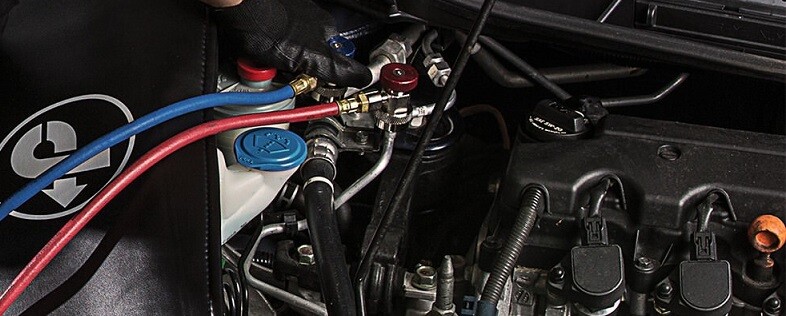The History of Car Air Conditioning
Car air conditioning is a system that cools and dehumidifies the air inside a vehicle, providing a comfortable driving experience for the occupants. It was first introduced in the 1930s and has since become a standard feature in most cars.
In this article, we will explore the history of car air conditioning, including its invention, development, and evolution over time.
Table of Contents
The Invention of Car Air Conditioning
The history of car air conditioning dates back to the 1930s when automobile manufacturers started experimenting with ways to cool the interior of cars. In 1939, Packard Motor Company made history by being the first automobile manufacturer to introduce air conditioning units in their cars. These units were manufactured by Bishop and Babcock (B&B), located in Cleveland, Ohio, and were installed in approximately 2,000 cars. The system was designed to cool the air inside the car using a refrigeration cycle. It consisted of an evaporator, a compressor, a condenser, and an expansion valve.
The evaporator was located inside the car, while the condenser was mounted on the outside of the car. The compressor was driven by the car’s engine, and the expansion valve regulated the flow of refrigerant through the system. The system worked by taking in warm air from the outside, passing it over the evaporator, which cooled and dehumidified the air, and then blowing the cooled air into the car’s interior.
Packard supported and warranted the air conditioning conversion, but it was not commercially successful due to several factors.
- The main evaporator and blower system occupied half of the trunk space, which was a significant drawback.
- More efficient air conditioning systems emerged in the post-war years, making the Packard system less attractive to car buyers.
- The Packard system had no temperature thermostat or shut-off mechanism, aside from turning off the blower, which allowed cold air to enter the car during movement.
- The several feet of plumbing going back and forth between the engine compartment and trunk were unreliable in service.
- The price was unaffordable to most people in depression/pre-war America, costing $274 (equivalent to US$5,338 in 2021 dollars).
As a result, the option was discontinued after 1941.
In addition to air conditioning units that were installed within the car itself, there were also “car coolers” that could be attached to vehicles. These were typically made of metal and were designed to hold ice or water, which would cool the air as it passed over the ice and into the car.
Car coolers were a popular alternative to air conditioning units in the early days of automobiles when air conditioning was not yet widely available.
Development of Car Air Conditioning
In the 1940s and 1950s, car air conditioning systems became more common, but they were still considered a luxury feature. They were expensive and bulky, and they added significant weight to the car. The early systems also used a lot of energy and were not very efficient.
One of the challenges of early car air conditioning systems was the size of the components. The compressor, condenser, and evaporator were large and took up a lot of space. This made it difficult to install them in smaller cars, which were becoming more popular in the 1950s.
In the 1950s, some car manufacturers started experimenting with different types of air conditioning systems. For example, General Motors introduced a system called the “Air-O-Matic” in 1954, which used a system of vents and fans to circulate cool air throughout the car. However, this system was not very effective and was quickly abandoned.
In the 1960s, car air conditioning systems became more compact, efficient, and affordable. They also became more reliable, thanks to advances in technology and manufacturing. By the end of the decade, the car air conditioning had become a standard feature in many cars.
One of the key innovations of the 1960s was the introduction of the hermetically sealed compressor. This type of compressor was smaller and more efficient than previous models and did not require as much maintenance. It also helped to reduce the size of the air conditioning system, making it easier to install in smaller cars.
Another innovation of the 1960s was the introduction of the first fully automatic air conditioning system. This system used sensors to monitor the temperature and humidity inside the car and automatically adjusted the temperature and fan speed to maintain a comfortable environment.
Evolution of Car Air Conditioning
In the 1970s and 1980s, car air conditioning systems continued to evolve. They became even more efficient and reliable, and they also became more environmentally friendly. In the 1990s, car manufacturers began to use new refrigerants, such as R-134a, which were less harmful to the environment than older refrigerants.
One of the key developments of the 1970s was the introduction of the “cycling clutch” compressor. This type of compressor only operated when it was needed, which helped to reduce energy consumption and improve the efficiency of the air conditioning system.
Another innovation of the 1970s was the introduction of the “receiver-drier” component. This component removed moisture and contaminants from the refrigerant, which helped to improve the efficiency and reliability of the air conditioning system.
In the 1980s, car manufacturers started using more advanced electronic controls for the air conditioning system. These controls allowed for more precise temperature and humidity control, as well as better energy efficiency. They also allowed for more advanced features, such as dual-zone climate control, which allowed the driver and passenger to set different temperatures for their respective sides of the car.
In the 1990s and 2000s, car air conditioning systems continued to evolve. They became more compact, lighter, and more efficient. They also became more integrated into the overall design of the car, with controls and vents becoming more streamlined and better integrated into the dashboard.
One of the key innovations of the 2000s was the introduction of “eco-friendly” air conditioning systems. These systems used new refrigerants and other components that were designed to be more environmentally friendly and reduce the impact of the air conditioning system on the environment.
Another innovation of the 2000s was the introduction of “smart” air conditioning systems. These systems used sensors to monitor the outside temperature, humidity, and other environmental factors, as well as the driver’s and passengers’ preferences, to automatically adjust the temperature and fan speed for optimal comfort and energy efficiency.
Future of Car Air Conditioning
The future of car air conditioning is likely to be driven by a few key trends. One of these trends is the increasing focus on environmental sustainability. Car manufacturers are likely to continue to develop air conditioning systems that are more energy-efficient and use more environmentally friendly refrigerants and components.
Another trend is the increasing use of advanced technology in car air conditioning systems. With the advent of the Internet of Things (IoT) and other advanced technologies, it is likely that car air conditioning systems will become even more connected and integrated into the overall design of the car.
Finally, there is likely to be an increasing focus on the user experience of car air conditioning systems. As cars become more connected and more technologically advanced, drivers and passengers are likely to expect more from their air conditioning systems in terms of comfort, convenience, and ease of use.
Conclusion
The history of car air conditioning is a story of invention, development, and evolution. From the bulky and expensive systems of the 1930s to the compact, efficient, and eco-friendly systems of today, car air conditioning has come a long way.
As the world continues to change and evolve, it is likely that car air conditioning systems will continue to evolve as well, driven by a focus on environmental sustainability, advanced technology, and the user experience.




